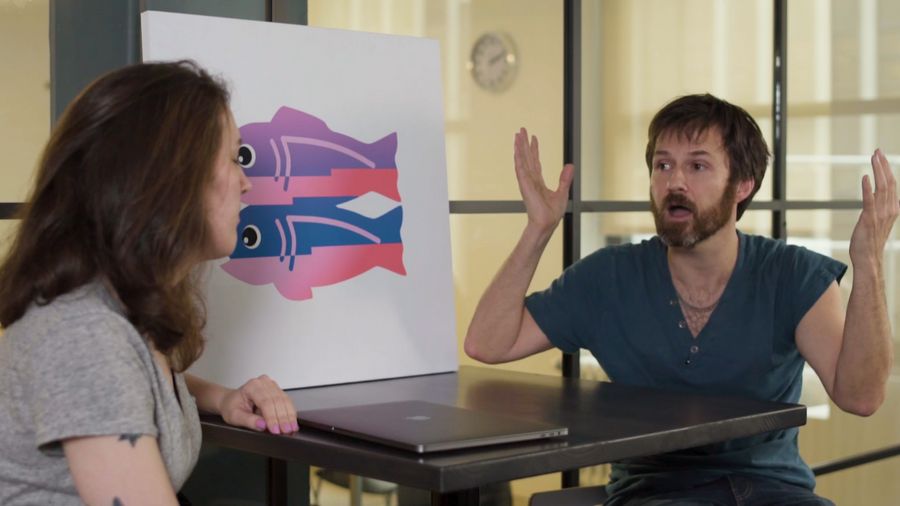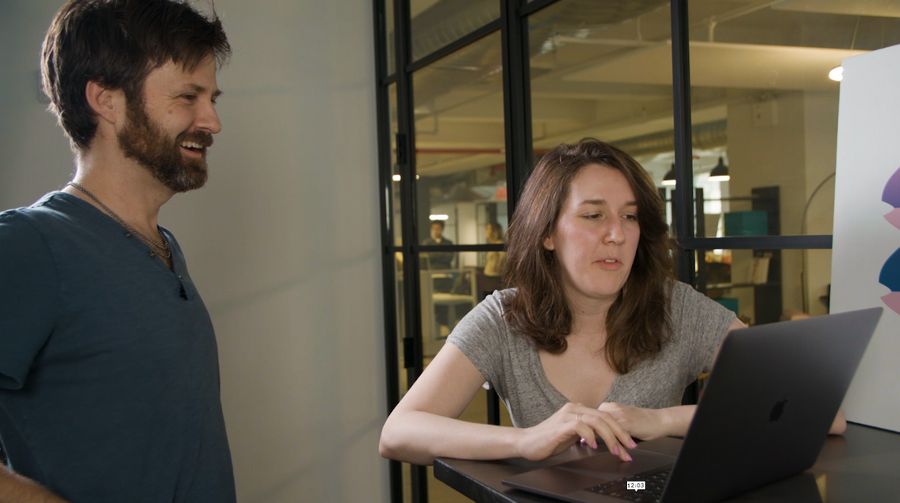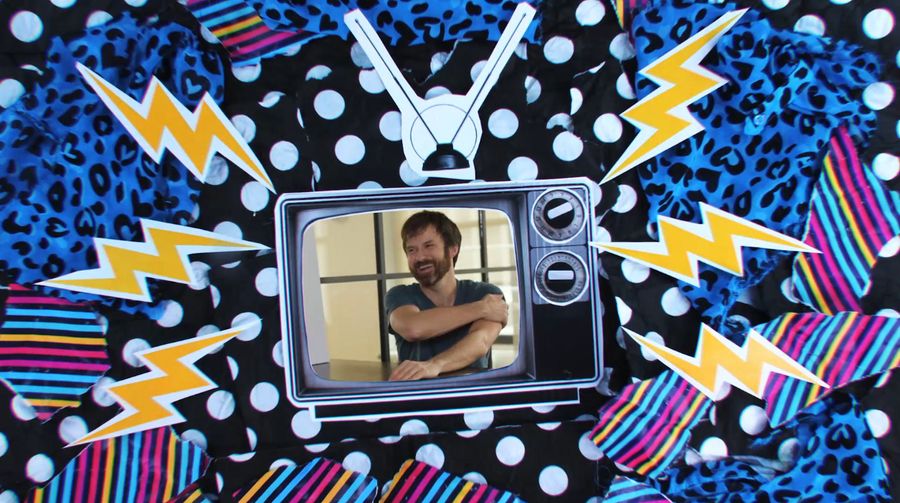Talking Music and Tech with Web Developer Travis Morrison — Part 2 of 2
Key Links #
- Travis Morrison’s Website
- Travis Morrison on Wikipedia
- The Dismemberment Plan
- Shoutabl
- Jenn Schiffer’s example Web Audio API Glitch app
Transcript #
Jenn Schiffer: How has technology effected music in bad ways?
**Travis Morrison: **Jesus…you want me to count the ways?
**Jenn Schiffer: **People who are building software to democratize using technology in music, like having a place where you can like sell your stuff. Or say we were going on tour or whatever. You had started a startup, right? For music. Shoutabl.
**Travis Morrison: Yeah it didn’t really work. **I learned a lot of lessons about tech; a lot of things in tech and music and business don’t work.
**Jenn Schiffer: **What’d you learn?
**Travis Morrison: **That it’s very hard to come up with a profit structure. I mean, you do have to keep the lights on. How will you get money from people who make music? That’s where the predatory comes in.
**Jenn Schiffer: **There are a lot of places that were like, “oh, if you want to have your stuff streaming on these sites and you want to do it all at once, you have to like pay $300 to this one company and they’ll like do it for you” and it’s like…you could actually go around that. It’s a little more inconvenient, but like it takes more work.
**Travis Morrison: **Yeah, yeah.
**Jenn Schiffer: **People aren’t really that upfront with it.
**Travis Morrison: **That’s right.
**Jenn Schiffer: **Music and tech definitely sort of like have its parallel —
**Travis Morrison: **I don’t trust tech to solve these problems at all.
**Jenn Schiffer: **Oh no…no…because again, art’s gonna get good, music’s gonna get good but like technology is not…
**Travis Morrison: **Right?
**Jenn Schiffer: **Yeah. And I think when people say art is gonna get good and music’s gonna get good, people are gonna pay more attention to what has been out there.
**Travis Morrison: **Right.
**Jenn Schiffer: **And the more people pay attention, the more empowered those creators are to keep making it. And that’s what’s important.
**Travis Morrison: **With these times and the tech stuff, I get stressed out when I see so many of these problems and people attempting to solve them on platforms like Twitter which, you know, I don’t know if Black Lives Matter or anything could happen without Twitter but at the same time, you always have to be mindful of the fact that you’re playing on a field in a stadium, but it’s a commercial product built by an industry with motivations that were not inclusive when they built it. Those conversations are happening inside a shell — a container that was like put together by those very energies that have some very questionable motivations.
**Jenn Schiffer: **Right.

**Travis Morrison: **The actual conversation itself might be part of what’s driving a lot of people crazy when they have these conversations in these contexts. You can’t even account for it. But you go to Twitter, and that’s a thing that was built by those motivations — those capitalists, white male motivations. And that’s something everyone should think about every time they start typing.
**Jenn Schiffer: **Yeah, ’cause like you said, like tech won’t be able to solve those problems. I think that it can just to people who are in tech today, as a whole, aren’t listening well enough. And it takes listening to solve problems.
**Travis Morrison: **It’s a historical problem.
**Jenn Schiffer: **Right. Exactly. I feel like we just do that a lot; we just sort of smile and shake our head “no” all the time.
**Travis Morrison: **Right?
**Jenn Schiffer: **I feel like one of the solutions to allowing tech to be open to actually solve problems instead of causing more is lowering the barriers to get into tech for underrepresented people.
**Travis Morrison: **Oh yes.
**Jenn Schiffer: **And with Glitch, we are trying to do that by creating a free tool to build off of your dreams; the ability to learn how to code and remix other apps that people have made. And it’s in the browser and it’s their web applications. I think one of the coolest things with regards to music and the web is the web audio API, which is fairly new.
**Travis Morrison: **It’s super cool.
**Jenn Schiffer: **The MIDI API’s also.
**Travis Morrison: **I’ve been playing with it the last couple years.
**Jenn Schiffer: **Yeah, yeah.
**Travis Morrison: **The little synthesizer.
**Jenn Schiffer: **Yeah, exactly, it’s cool. I grew up with a huge respect for music and musicians.
**Travis Morrison: **Yeah.
**Jenn Schiffer: **Like my father used to drag me inside whenever “Billie Jean” was playing on VH1.
**Travis Morrison: **Yeah.
**Jenn Schiffer: **And so he really like instilled in me the artistry behind it. I always had access to music through like television, fortunately, and by then all the money that I had — which was very little — went towards CDs and cassettes and stuff.
**Travis Morrison: **Right, right, yeah, yeah.
**Jenn Schiffer: **And I was really super into my friends who were all in bands, so a lot of music I was listening to all through college were just like local friends and their friends and fortunately they were good, you know?
**Travis Morrison: **Right. Your friends’ music is very important. That’s like…it’s such a primal way, sometimes, especially with young people, a much more accurate way to know how someone’s feeling than them talking.
**Jenn Schiffer: **Yeah.
**Travis Morrison: **I could barely speak until I was like 33 years old. Like, I could talk a blue streak, but never made any sense.
**Jenn Schiffer: **Yeah.
**Travis Morrison: **Your friends giving you music is like… “I’m trying to tell you something.”
**Jenn Schiffer: **Right, yeah, they’re like, you know little love notes and stuff.
**Travis Morrison: **Little love notes, yeah. Many emotions.
**Jenn Schiffer: **Yeah. And I think as we’re working on a product that is trying to facilitate open source, I’m always constantly thinking about licenses and trying to promote the open web.
**Travis Morrison: **Right.
**Jenn Schiffer: **So I think a lot about how piracy is affected by that. If you democratize building software, you’ll have different options. And I think now the struggle is convincing companies that are consuming open source to give back in some sort of way. And a lot are. Like Linkedin — they have a lot of Ember core developers that work for them, and they allow those developers to give a lot back to the open source community, which is really cool. And so, I want to see that trend kind of move along.
**Travis Morrison: **Right.
**Jenn Schiffer: **But I also like the fact that browser vendors and people building APIs for browsers are thinking more creatively on what can be done in the browser. It’s not just like putting text in video, but like the ability to create music.
**Travis Morrison: **Yeah.
**Jenn Schiffer: **And I know a lot of people who were working on it, and they were all musicians and they were all like creating music and…it’s very empowering to build your own tools to make your own art.
**Travis Morrison: **That is true.
**Jenn Schiffer: **And to open it for everyone else to do.
**Travis Morrison: **Yeah, that is true.
**Jenn Schiffer: **Yeah.
**Travis Morrison: **Because I think diversity in the creators of this industry is the only hope. Well…and the money. There needs to be more diversity in terms of who gets —
**Jenn Schiffer: **Who gets that money.
**Travis Morrison: **Who gets bucks to try a thing. And the amount of white men giving other white men things to like try. I don’t know if I should use a visible new business — no, I’m not — but you see things sometimes and you’re like “a white man gave a white man some cash for that really dumb idea; that was really, really dumb.” Do you think there’s anything else that needs to be done besides current initiatives for continuing to push open diversity on tech teams?
Jenn Schiffer: I get asked that a lot, as a “woman in tech,” who therefore represents all women in tech.
**Travis Morrison: **You’re a WITty.
**Jenn Schiffer: **Yeah, what we should do about diversity, inclusivity…and my answer’s always dependent on who asks. Always call out people who are actively hostile towards women because that’s a thing that’s happening or, you know, get these guys to give me a ton of money. I’ll help them distribute it. If you can’t do it yourself, let me help you.
**Travis Morrison: **Right, right, right. You certainly get to that point where you’re like, “I know I gotta do something about this but I only know white men.”
**Jenn Schiffer: **Yeah.
**Travis Morrison: **And I think they only know white men. And yes, that’s where you’re like, “would you like to pay me?”
**Jenn Schiffer: **Yeah.
**Travis Morrison: **I know women and people of color; I can help you with that.
Jenn Schiffer: Yeah.
**Travis Morrison: **I think that is a thing actually. You know what I was thinking would be cool? Whenever I think something’s gonna be cool, that’s the cue for someone to show me that nine people have done it and I’m like totally out of touch and corny. In light of my comment about how people are forgetting that the very nature of Twitter conversations are framed in the ideas of the old tech’s power and idea structure and money structure? I would love like a blue sky thing to see women and people of color to put out proposals for the next great social network. I don’t really buy the idea that Snapchat’s a social network. I think it’s a way for two people to send things to each other.
**Jenn Schiffer: **Snapchat is the most popular social media app for people age 13 to 25.
**Travis Morrison: **But is it social?
**Jenn Schiffer: **It is social.
**Travis Morrison: **Is it more social than, is it as SMS social?
Jenn Schiffer: SMS is social.
**Travis Morrison: **Okay, if you consider SMS social.
Jenn Schiffer: Yeah.
**Travis Morrison: **But no…wait, is email social?
Jenn Schiffer: Email’s social.
**Travis Morrison:**Okay.
**Jenn Schiffer: **I think our idea of what social is, is what young people are using.
**Travis Morrison:**Right.
Jenn Schiffer: I don’t think that’s the case, but I think that’s what people think.
**Travis Morrison:**Have any of these been the vision of a woman or person of color? I don’t know if a Puerto Rican kid from Chicago who sketches out their idea of the next social network to fix the problems of the past ones or to take advantage of new demand that really had been not noticed. What would that look like?
Jenn Schiffer: Besides solving the diversity and inclusivity crisis in tech —
**Travis Morrison: **We did it!
Jenn Schiffer: What’s next for you? What are you gonna be working on?
**Travis Morrison: **Well, I’m moving to Durham. The thing I said before about the great tech dispersal? I’m doing it! I’m moving back to a purple state. I grew up in Virginia, and so getting into that community is probably gonna be a lot of my 2018. Continue working…hopefully finish another album.
**Jenn Schiffer: **One final, very, very important question: will the baby learn how to code or learn how to play guitar first?
**Travis Morrison: **Oh, he’s playing guitar already.
**Jenn Schiffer: **He’s playing guitar already?
**Travis Morrison: **Yeah.
**Jenn Schiffer: **Well thank you so much for coming in and chatting.
**Travis Morrison: **Yeah, thank you.
**Jenn Schiffer: **Always fun.
**Travis Morrison: **It’s always fun.
Jenn Schiffer: Yeah, Travis Morrison.
[The camera shifts to focus on Jenn’s laptop as she demonstrates a Glitch app using the Web Audio API. Travis stands next to her. The opening guitar riff to “When Doves Cry” by Prince plays over the laptop’s speakers.]
**Jenn Schiffer: **So this is a frequency visualization — you’ve probably seen this many times — and this is all in the browser using the web audio API. So my JavaScript: I start off where I have [audio] in my assets, [and] they’re converted to mp3 MIDI files, and I just have an array of objects called songs that have the title and the artist, which is what shows up here. And then when the app gets started, I want to create a sort of audio buffer so that when I press J, [it] loads a random song. The song loads and then plays when it’s ready and as the song is playing, it draws onto an HTML5 canvas the text that says the artist and song title and also all the bars for that frequency chart.
**Travis Morrison: **Right. Yeah.
**Jenn Schiffer: **Because the web audio API gives you back a data array of, like, all the buffer lengths.
**Travis Morrison: **Yeah.
Jenn Schiffer: So that builds this. Let me unmute it again. You can see what else comes up. Another classic.
[“Every Day Is A Winding Road” by Sheryl Crow plays next.]
**Travis Morrison: **Right. Man, Sheryl. How did she do it?
**Jenn Schiffer: **The cool thing about Glitch is that you can have it auto-refresh or it auto-deploys whenever you —
**Travis Morrison: **Yeah, show that to me.
**Jenn Schiffer: **Yeah, sure.
**Travis Morrison: **Prove it.
**Jenn Schiffer: **Yeah…so I’m gonna refresh app on changes so I don’t have to click refresh. I want to change the color of those bars, so I’m gonna make it…I guess I’ll make it a little less green and see what happens.
**Travis Morrison: **Is that a hue value?
**Jenn Schiffer: **These are RGB values.
**Travis Morrison: **Oh.
**Jenn Schiffer: **The fill text, that’s for this. Oh actually, this is position I’m changing…ignore that. Down here, the RGB value…
**Travis Morrison: **Yeah.
**Jenn Schiffer: **It’s starting out as like a turquoise-ish…
**Travis Morrison: **Yeah.
**Jenn Schiffer: **But if I wanna make it more red…
**Travis Morrison: **Yeah.
**Jenn Schiffer: **I’ll do 150. RGB values — the red, green, and blue — can be zero to 255.
Travis Morrison: Yeah.
**Jenn Schiffer: **I’m gonna say barHeight.
**Travis Morrison: **Oh yeah, sorry.
**Jenn Schiffer: **I’m gonna lower the G and then keep that there. Let’s see what happens. Oh, purple-ish.
[“Girlfriend In A Coma” by The Smiths plays next.]
**Travis Morrison: **Yeah, but you changed it. I saw it, I saw you do that.
**Jenn Schiffer: **So another cool thing about the app is maybe…I mean, this is the ultimate playlist. But let’s say you wanted to —
Travis Morrison: Because you don’t need any other music.
**Jenn Schiffer: **You don’t need any other music, but let’s say in a less perfect world, you do need more songs. Because I have this as an unprivate project, you can remix this and have your own copy made and deployed with it’s own, different URL. My original project is guiltless-answer.
**Travis Morrison: **Yeah.
**Jenn Schiffer: **And Glitch here has created . And you can show that.
**Travis Morrison: **Wait, what’s going on up there? What are these?
[Travis points to Jenn’s laptop screen.]
**Jenn Schiffer: **These are just automatically generated names; you can change them if you like. So within seconds, there’s this new copy here that works the same way. So you can remix my app later. You should.
**Travis Morrison: **Oh yeah, I’m gonna.

**Jenn Schiffer: **You can update the songs, or not, and change the colors.
**Travis Morrison: **What’s the word?
**Jenn Schiffer: **Remix.
**Travis Morrison: **Remix. When I remix it, it’s a totally new thing moving forward. It’s like hitting “copy” in a Google doc.
**Jenn Schiffer: **Right.
**Travis Morrison: **That’s right, right, right.
**Jenn Schiffer: **So the difference between just branches is that you’ve cloned it and it’s deployed. We do all the DevOps stuff for you so you don’t have to worry about how to get it online. It already is.
**Travis Morrison: **What’s the public face? Is it…dot glitch dot me?
**Jenn Schiffer: **Yeah.
**Travis Morrison: **Could I point a full domain at it?
**Jenn Schiffer: **We will have that sometime in the future. Right now, it’s just subdomains.
**Travis Morrison: **I’m actually gonna start using this tomorrow. Does this have any stateful services, or is it strictly like a web app; you load it and then you can work with it?
**Jenn Schiffer: **If you add a package, that JSON file becomes a note app; you can import packages through there.
**Travis Morrison: **Oh okay.
**Jenn Schiffer: **We have examples on glitch.com, which is our community site. I’m logged in here. We have different projects like…how about building blocks that get you started with other things like including persistence with MongoDB or REST APIs…Auth0 for, you know, if you don’t wanna do auth, you wanna do third party auth. We have all sorts of things that you can then take and remix and build upon it yourself.
Travis Morrison: Oh okay, cool, well there you go.
**Jenn Schiffer: **Yeah.
**Travis Morrison: **This is super cool. I’ll take two.

